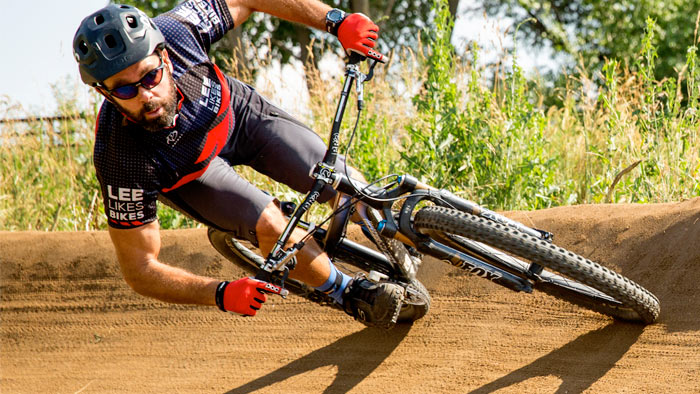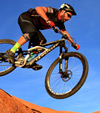My name is Lee, and I’ve taught riding skills to thousands of riders of all levels. In this article I want to share one of the secrets of successful mountain bikers: the pump track.
What is a Pump Track?
A pump track is a continuous loop of round bumps and banked turns that you ride not by pedaling, but by “pumping.”
What is Pumping?
Pumping is the art of managing pressure to minimize impacts and generate propulsion. Basically, you get heavy on the backs of bumps and light on the fronts of bumps. If you’ve ever skateboarded in a bowl or skied moguls, you’ve pumped. Here we test-ride a track we built in Longmont, Colorado:
How Will Pumping Change my Trail Riding?
As your pump track skills soak into your mind and body, you’ll see your normal trails in an entirely new way. Instead of obstacles, you’ll see opportunities. Red dotted lines will pass over boulders you’ve been avoiding. You’ll ride much smoother and faster, and it will actually feel easier. Have you ever seen a rider flow like water though a gnarly rock garden? He or she is pumping. There is no other way.
How can Pump Track fit into my Training?
If you’re a mountain biker, you have to do a lot more than pedal. Keep doing your prescribed intervals, but be sure to fit in some pump track time as well. Not only will pump tracking create fun new skills, it will build total, usable strength for mountain biking. I like to mix pump track into my training programs. Here are some examples:
- Sweet spot or threshold intervals. You have to be pretty skilled to keep your effort level this low. Focus on smoothness, and keep pumping for the prescribed interval time. If you can pump continuously for 20 minutes, you are ready for the world tour.
- Suprathreshold intervals. We all know how hard and miserable these can be. Try them on a pump track. Full power for 30 seconds, try to recover for 30 seconds, repeat as many times as you have to. This is a lot more fun than the trainer, and it will make you strong.
- Neuromuscular, aka sprint, intervals. Dirt jumpers and downhillers call this “play.” Go as fast as you possibly can for a short section. Rail a berm. Try to jump some rollers. Give it full power. Have fun!
Which Bike Should I Ride?
A BMX or dirt jump bike is ideal, but your trail or cross country mountain bike will work fine. I do most of my pump tracking on a trail bike: either a Specialized Camber, Stumpjumper or Enduro. These are all 29ers, by the way. Here are some tips for bike setup:
- Drop your seat. This gives you room to move.
- Shorten your stem. This increases your range of motion.
- Add air to your tires. Low pressures make for squirmy rides and burped air. I generally ride pump track with 40 psi vs. 30 psi on trail.
- Don’t lock it out. While your lockout or pedaling platform will theoretically help you pump more efficiently, I suggest riding your bike the way you ride it on trail. This is more consistent, and a strong rider will blast through the platform anyway.
How do I Ride a Pump Track?
I’d love to show you in one of my clinics or books, but here are the basics:
- Balance on your feet. That’s always the biggest priority.
- Enter with a bit of speed. Roughly a slow jogging pace. Enter too fast and pay the price.
- Start with your arms. Pull up the bumps and push down the bumps. This gets you in phase with the wave, and it gives you some propulsion.
- Add legs. This is where true pump power comes from. Push down on the backs of the bumps, then let your bike roll lightly up the fronts of the bumps. The harder you push down the back, the more speed you get and the more you erase the front. If you’re a skier, imagine ripping a mogul line. It’s the same thing.
When you get it right, pumping delivers you a beautiful feeling of speed and smoothness. If you pay attention to the feedback the track gives you, you’ll learn quickly.
Where Can I Find a Pump Track?
More and more towns, cities, parks and schools have pump tracks. Ask at your local bike shop or search online. If you can’t find a pump track, build your own!
How Can I Build my own Pump Track?
Pump tracks can be big and costly, but the best ones are small and inexpensive — and they fit into a typical back yard. All you need is some space, some dirt and either a rented Bobcat or some friends. The physical labor is great for you: By the time you build your pump track, you’ll be strong enough to ride it!
The eBook “Welcome to Pump Track Nation” has been used to design and build thousands of pump tracks all over the world.
For ready-to-build designs, custom tracks and/or building services, check out Lee Likes Bikes’ design and build services.


